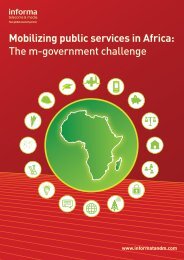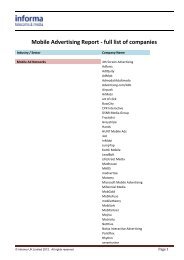The Future of MVNOs - Informa Telecoms & Media
The Future of MVNOs - Informa Telecoms & Media
The Future of MVNOs - Informa Telecoms & Media
Create successful ePaper yourself
Turn your PDF publications into a flip-book with our unique Google optimized e-Paper software.
<strong>Informa</strong>, however, believes that for Latin AmericanMNOs the option <strong>of</strong> teaming up with low-cost <strong>MVNOs</strong>to bring price competition to other MNOs is notparticularly attractive. In the prepaid-dominated LatinAmerican markets, the potential negative impact <strong>of</strong>low-cost <strong>MVNOs</strong> on an already flat or declining ARPUis a major concern for MNOs. Latin American MNOswill be more interested in teaming up with <strong>MVNOs</strong>that, although helping improve EBITDA margins, canalso bring additional revenues from unaddressedniches willing to use incremental airtime and dataservices (see fig. 4).Fig. 4: Selected operators, EBITDA margin, 3Q11Margin (%)50403020100Movistar(Argentina)Claro(Brazil)TIM(Brazil)Source: <strong>Informa</strong> <strong>Telecoms</strong> & <strong>Media</strong>Telcel(Mexico)<strong>Informa</strong> also believes that pricing will be crucial to thesuccess <strong>of</strong> the higher-value data <strong>MVNOs</strong>. In additionto the well-known benefits <strong>of</strong> the MVNO model,higher-value data-focused <strong>MVNOs</strong> can help provideincremental revenues to <strong>of</strong>fset declining ARPUlevels. Finding the correct pricing levels and models,however, is a tough task. As in the case <strong>of</strong> VirginMobile in Latin America, data <strong>MVNOs</strong> will be eagerto add smartphones to their data plans, but withoutsubsidies it can be challenging to meet customerdemand for the devices at the right price.At the same time, <strong>MVNOs</strong> must be able to negotiategood wholesale rates from MNOs for the data they thensell at retail. In the retail market, MNOs are movingaway from flat rates and toward models where theycharge by actual data consumption, by time or by accessto selected apps. MNOs themselves are still strugglingto find efficient ways to price data services in the retailmarket. When it comes time to negotiate wholesaledata prices, <strong>MVNOs</strong> face the risk <strong>of</strong> remaining stuckwith unfavorable conditions, which could ultimatelyjeopardize their business model.Orange(France)Vodafone(UK)AT&T(US)Triple play will remain amajor MVNO driverChallenging fixed-line operators and ISPsshould exploit the MVNO model to develop morecompetitive <strong>of</strong>feringsMost <strong>of</strong> the early Latin American <strong>MVNOs</strong> have been drivenby the opportunity to <strong>of</strong>fer fixed/mobile bundles, especiallyin the most concentrated markets, such as Mexico andColombia (see fig. 5). It is not a coincidence that despitethe absence <strong>of</strong> a full regulatory framework, both Movistarin Mexico and Tigo in Colombia have taken advantage <strong>of</strong>existing rules allowing telecoms services to be resold tobuild MVNO partnerships with ISPs and cable players. Toerode shares <strong>of</strong> strong competitors in their respectivemarkets, Movistar and Tigo have established <strong>MVNOs</strong>with fixed operators looking to add value to their bundles<strong>of</strong> voice, TV and Internet service by including mobility.Movistar was the first to pursue this strategy, when itteamed up with Maxcom at the start <strong>of</strong> 2008. Similarly, Tigoin Colombia has partnered with ISPs UNE EPM and ETB to<strong>of</strong>fer mobile broadband services to contract customers.For the foreseeable future, <strong>Informa</strong> expects alternativeISPs, especially in the most unbalanced fixed-linemarkets, to retain a strong interest in the MVNOmodel with the aim <strong>of</strong> increasing customer loyaltyFig. 5: Brazil, Argentina, Colombia, Mexico, marketshare and concentration, 3Q111009080706050403020100Market share (%)America Movil Telefonica Millicom Telecom ItaliaTelecom Personal Oi Others*BrazilArgentinaConcentration: Herfindahl indexColombiaMexico0.25 0.32 0.51 0.54Notes: <strong>The</strong> Herfindahl index is defined by the sum <strong>of</strong> the squares <strong>of</strong> themarket shares <strong>of</strong> all firms in the market, where the market shares areexpressed as fractions. An index below 0.01 indicates a highly competitivemarket. An index below 0.15 indicates an unconcentrated market. Anindex between 0.15 and 0.25 indicates moderate concentration. An indexabove 0.25 indicates high concentration. *Nextel, CTBC and Sercomtel InBrazil; Iusacell and Nextel in Mexico; and Nextel in Argentina. TelecomItalia owns 22.9% <strong>of</strong> Telecom Personal in Argentina.Source: <strong>Informa</strong> <strong>Telecoms</strong> & <strong>Media</strong>6© 2012 <strong>Informa</strong> UK Ltd. All rights reserved. www.informatandm.com











